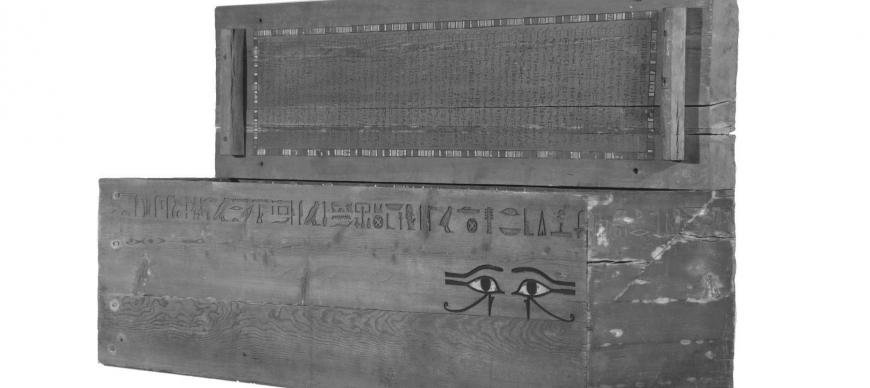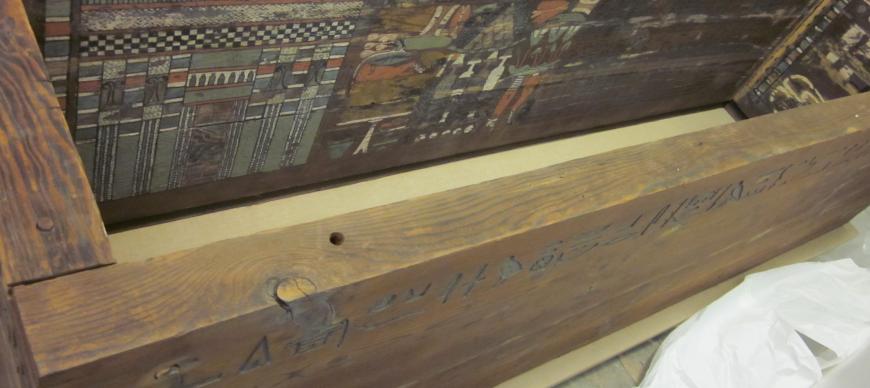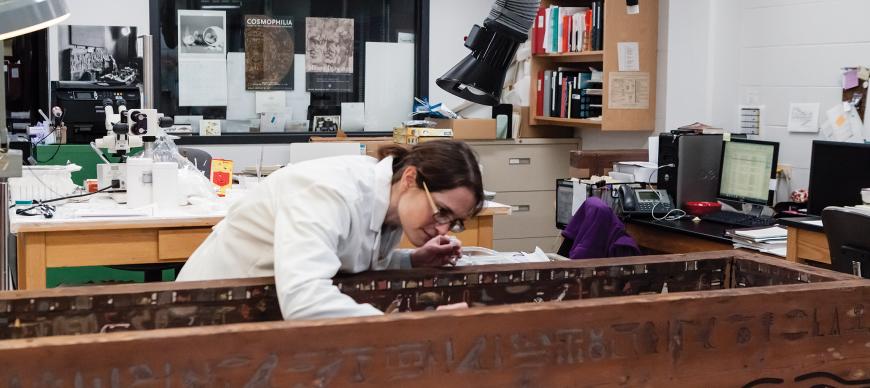The Oriental Institute recently received a grant from the Antiquities Endowment Fund of the American Research Center in Egypt (ARCE) to conserve an important ancient Egyptian coffin in our collection (OIM E12072; see fig. 1). The First Intermediate Period (ca. 2064 BC) coffin of the commander and scribe of the army troops Ipi-ha-Ishutef was purchased by James Henry Breasted in Cairo in 1923. It is an excellent example of the coffin maker’s art, being constructed of large planks of what was assumed to be cedar from Lebanon. The outside is inscribed with funerary texts invoking offerings for the soul of Ipi-ha-Ishutef. A pair of wedjat eyes allowed the soul of the deceased to see the rising sun, a symbol of eternal rebirth. The interior is painted with a colorful scene of weapons, jewelry, food, and supplies for the soul of the deceased in the afterlife (fig. 2). The decoration also includes the representation of a door that allowed his spirit to leave the dark realm of the coffin to enjoy offerings left in the tomb. Unlike contemporary coffins inscribed with what are known as the Coffin Texts, the lid of this example bears an earlier composition known as the Pyramid Texts.
The coffin, a prior museum “highlight object,” was displayed in the Egyptian Hall until the 1996 gallery closure to prepare for the major refurbishment project and the creation of the new Joseph and Mary Grimshaw Egyptian Gallery. When the coffin was removed from display and transferred to storage, it was realized that a program of conservation would be required to stabilize its fragile wooden structure and its painted surface. Due to the vertical nature of the coffin walls, some fragments of pigment are literally hanging off these surfaces. Our commitment to dedicate adequate funding and staff time to carry out this conservation treatment on the coffin motivated us to make the recent funding request to the Antiquities Endowment Fund. We’re very grateful to have ARCE’s support — this organization mainly provides grants for cultural heritage and preservation projects in Egypt itself, but it also supports conservation projects on Egyptian collections in American museums.
The grant will allow conservator Simona Cristanetti to work on the coffin in the Oriental Institute’s conservation laboratory. The first stage (in preparation at the time of writing) is to move the coffin from our Organic Storage to the conservation laboratory, where it can be fully documented and conserved (fig. 3). Prior to conservation treatment, the coffin will be carefully analyzed using a variety of scientific techniques. The information we hope to gain from these analyses will add to the growing body of information on the organic and chemical compositions of pigments used in ancient Egypt. The coffin conservation project follows a study of the wood of the coffin done at the Laboratory of Tree Ring Research at the University of Tucson. In the 1930s, cores of the wood were sent to Tucson. Now, after more than three quarters of a century, a study, headed by Sturt Manning and Pearce Paul Creasman, aided by Oriental Institute doctoral candidate Kathryn Bandy, has been published in the Journal of Archaeological Science (vol. 46, 2014). Their study verified that the coffin is made of cedar, and it assigned a date of 2081–2064 BC to the last extant tree rings. The final report will include a description of the coffin and its iconography, its conservation, and an analysis of the wood and pigments. A report on the current conservation project will also be published in the ARCE Bulletin.
Once the conservation treatment of the coffin has been completed, it will be displayed in the Joseph and Mary Grimshaw Egyptian Gallery positioned near the Ptolemaic mummy of Petosiris and the Third Intermediate Period cartonnage of Meresamun, giving our visitors a vivid illustration of the evolution of coffin design. We look forward to welcoming back commander Ipi-ha-Ishutef’s coffin in the summer of 2015!
By Jack Green, Oriental Institute Museum Chief Curator
Excerpt from Oriental Institute News & Notes Quarterly Newsletter, Issue 224, Winter 2015 (Download the PDF)
Visit the the Conservation of the Coffin of Ipi-ha-ishutef Project webpage to learn more.




